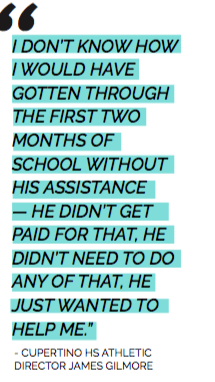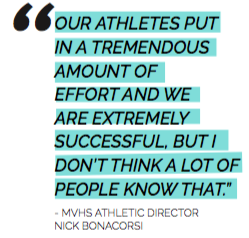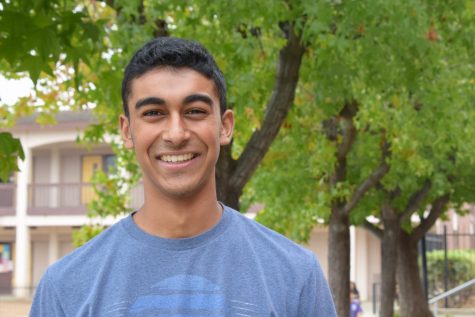Head of the game
February 6, 2019
He typically stops responding to emails at around 7 p.m. When he comes into work the following morning, his inbox is full; there are already between 30 and 50 emails to respond to. The topics of the emails vary, whether it’s communicating with a player, coach, referee or another athletic director, but one thing is for certain — athletic director Nick Bonacorsi is always busy.
“I mean, the job description is quite expansive,” Bonacorsi said. “Nothing you’ve done really prepares you for [this] job. I’ve been involved with athletics my whole life, playing, coaching, so at least I have an understanding of the general expectation for the job, but I think it takes probably about three years to really understand the job and do it well. Because the first couple years, you’re really just treading water.”
Despite Bonacorsi being in the midst of his fourth year as athletic director, he explains that he is just beginning to settle in. In November, he was given the Norm McKenzie award by his fellow CCS athletic directors, a recognition that goes to a “rookie athletic director.” He will receive the physical award in April at the California State Athletic Directors Conference.
“I didn’t even realize I was nominated, so it definitely caught me by surprise [when I heard I won],” Bonacorsi said. “But it’s humbling. It’s sort of gratifying in a way to know that maybe some of the things you’re working really hard on are making a difference or being seen, and it’s bringing exposure to our athletic department, so it’s exciting.”
Lynbrook HS’ athletic director Jennifer Griffin was one of the two people who nominated Bonacorsi for the award. Griffin emphasizes that last year, Bonacorsi helped her get started as a new athletic director. She adds that LHS and MVHS both have an academically-driven environment, so it was easy for herself and Bonacorsi to get along because they shared similar goals for their programs.
“I would not have survived last year without his help,” Griffin said. “He was very helpful and I could just send a text or call him whenever I [had] a question on anything. It’s nice to know that you have somebody that you can rely on in that way.”
When Bonacorsi first took the job, things weren’t running as smoothly. The previous athletic director stepped down right before the beginning of the school year, and Bonacorsi had to step in immediately. He says those first few months as athletic director were challenging because they required him to start right away and learn on the job.
Because of the initial difficulty of the job, Bonacorsi explains that it was helpful to have a network of more tenured athletic directors to rely on. Now, other new athletic directors regularly reach out to Bonacorsi to ask for assistance. Cupertino HS athletic director James Gilmore says because this is his first year in this new position, he has leaned heavily on Bonacorsi.
“There [were] three people who applied for the job [at CHS], and I was the one who ended up getting it. The two people who didn’t [get the job] happened to be the former athletic directors, so I wasn’t getting much support or help from them,” Gilmore said. “So at that point I reached out to [Bonacorsi] … I don’t know how I would have gotten through the first two months of school without his [assistance] — he didn’t get paid for that, he didn’t need to do any of that, he just wanted to help me.”

Gilmore’s goals also align with Bonacorsi’s “new athletic director model,” which work s on building athletes’ leadership skills, along with other factors such as mentoring younger coaches and placing equal priority on athletics and academics.
Like Griffin, he finds it easy to collaborate emphasizes the value of having a network of other athletic directors to rely on, and just like with Gilmore, Bonacorsi is an important part of that network.
“Anytime I had a question he was more than willing to help me out,” Griffin said. “[Being an athletic director is] a job that takes a lot of time, requires a lot of time, and so there’s not always a lot of extra time to give, but he’s always willing to go that extra step to help somebody else.”
This idea of building relationships between athletic directors is borrowed from Bonacorsi’s experience in the classroom as a history teacher, where he work s on building relationships with students. He stresses the importance of doing the same with athletes — he wants them to be the main focus of the athletics program. In focusing on the athletes themselves, Bonacorsi has given them more power over the past few years by creating the Student Athletic Senate, along with collaboration groups for team captains to learn about leadership. He admits that these two areas are where he has dedicated the most hours.

“I don’t really care about [the personal] awards [that I win] — I want our athletic department to have more exposure [because] I think our athletes work really hard and put in a tremendous amount of effort and we are extremely successful but I don’t think a lot of people know that,” Bonacorsi said.
He explains one of his main goals is to change the culture so that athletes receive proper recognition, therefore improving their experience. For this cultural change to be possible, he believes that the effort must be lead by the athletes, which is what he is trying to do through the Student Athletic Senate. As a member of the Senate, senior Roann Acott appreciates that now there is a forum to bring up issues, especially those that may be common among many MVHS sports teams.
“I feel like freshman year we did have issues but we kind of just kept it on the [swim] team,” Acot said. “Now I’m in this position where we can talk to [Bonacorsi] about issues, [and] I feel like issues are more addressed now compared to before.”
Acot has also noticed Bonacorsi’s increased presence over the past two years when it comes to athletics — she has noticed him out on the pool deck a lot more often, compared to past years. Acot adds that he has improved by placing an equal priority on all of the sports teams. She says that he is always there to listen when there is a problem, and he will work with anyone to help fix it, whether that be a certain sports team, a coach or his athletic Senate.
“Whenever we have issues it’s like really easy to come up to him,” Acot said. “He definitely makes you feel important.”
The results of the Senate have been delightful for Bonacorsi to witness — he says the ideas the Senate has brought to him have been homegrown and organic, stressing that he would love to have anyone who’s interested come on board. That authenticity is crucial, he says, because to ensure cultural change, the athletes must be the ones leading it.
“There were some things I wasn’t happy with our athletic culture before and I don’t think we’re really where I want us to be, but I think we’re making huge improvements,” Bonacorsi said. “My hope is for athletics to not be a side product of the high school experience, but to be more ingrained into the high school experience.”

















